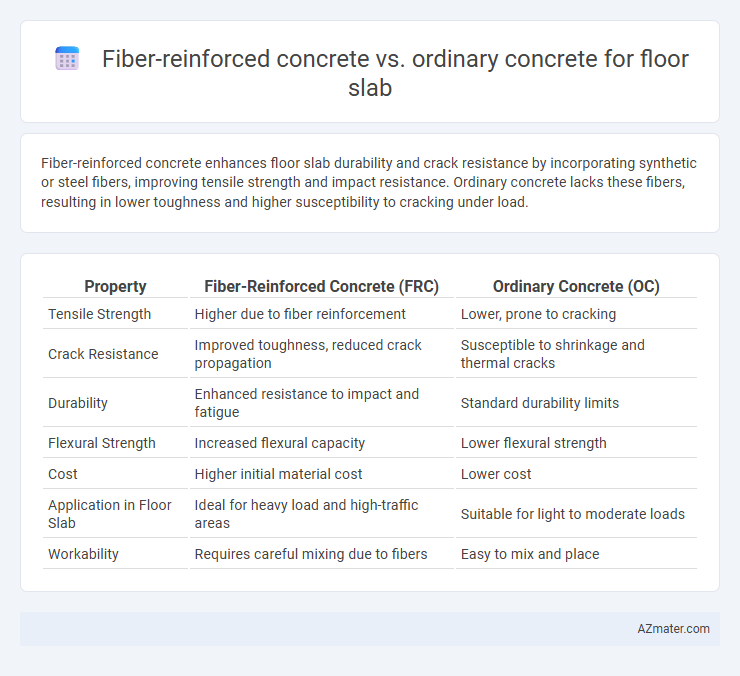Fiber-reinforced concrete enhances floor slab durability and crack resistance by incorporating synthetic or steel fibers, improving tensile strength and impact resistance. Ordinary concrete lacks these fibers, resulting in lower toughness and higher susceptibility to cracking under load.
Table of Comparison
| Property | Fiber-Reinforced Concrete (FRC) | Ordinary Concrete (OC) |
|---|---|---|
| Tensile Strength | Higher due to fiber reinforcement | Lower, prone to cracking |
| Crack Resistance | Improved toughness, reduced crack propagation | Susceptible to shrinkage and thermal cracks |
| Durability | Enhanced resistance to impact and fatigue | Standard durability limits |
| Flexural Strength | Increased flexural capacity | Lower flexural strength |
| Cost | Higher initial material cost | Lower cost |
| Application in Floor Slab | Ideal for heavy load and high-traffic areas | Suitable for light to moderate loads |
| Workability | Requires careful mixing due to fibers | Easy to mix and place |
Introduction to Concrete Floor Slabs
Fiber-reinforced concrete (FRC) enhances the mechanical properties of floor slabs by integrating synthetic or steel fibers, improving tensile strength, crack resistance, and durability compared to ordinary concrete. Ordinary concrete relies on aggregate, cement, and water with conventional reinforcement, often requiring additional steel rebar to control cracking and support loads. For concrete floor slabs, FRC offers superior performance in reducing shrinkage cracks and increasing impact resistance, making it ideal for industrial and commercial applications.
What is Fiber-Reinforced Concrete?
Fiber-reinforced concrete (FRC) is a composite material comprising Portland cement, aggregates, water, and dispersed fibers such as steel, glass, synthetic, or natural fibers, enhancing its tensile strength and crack resistance. Unlike ordinary concrete, which relies solely on its inherent compressive strength, FRC improves durability and toughness, making it ideal for floor slabs subjected to high stress and impact loads. The integration of fibers minimizes crack propagation and reduces maintenance costs, leading to longer-lasting floor slabs in industrial, commercial, and residential applications.
Ordinary Concrete: Composition and Characteristics
Ordinary concrete, commonly used for floor slabs, consists of cement, water, fine aggregates like sand, and coarse aggregates such as gravel or crushed stone, providing a balanced compressive strength typically ranging from 20 to 40 MPa. This conventional mix exhibits good workability and ease of placement but lacks enhanced tensile strength and crack resistance found in fiber-reinforced alternatives. Its homogeneous composition results in brittle behavior under tensile stresses, necessitating control joints and reinforcement for durability in floor slab applications.
Strength Comparison: Fiber-Reinforced vs Ordinary Concrete
Fiber-reinforced concrete exhibits significantly higher tensile strength and improved crack resistance compared to ordinary concrete, making it ideal for floor slabs subjected to heavy loads and dynamic stresses. The inclusion of fibers enhances ductility and impact resistance, reducing the risk of sudden failure and extending the service life of the slab. Ordinary concrete, while strong in compression, lacks the tensile reinforcement provided by fibers, resulting in lower overall durability in demanding floor slab applications.
Crack Resistance and Durability
Fiber-reinforced concrete significantly improves crack resistance in floor slabs by distributing stress more evenly and preventing the formation of micro-cracks, enhancing structural integrity. Its durability surpasses ordinary concrete due to added fibers that reduce shrinkage and resist impact, freeze-thaw cycles, and abrasion. Consequently, fiber-reinforced concrete extends the lifespan of floor slabs, reducing maintenance costs and increasing long-term performance in demanding environments.
Flexural and Tensile Performance
Fiber-reinforced concrete (FRC) significantly enhances flexural and tensile strength compared to ordinary concrete, reducing crack propagation and improving load-bearing capacity for floor slabs. The inclusion of synthetic or steel fibers provides increased toughness and durability, making FRC a preferred choice where higher structural resilience and impact resistance are critical. Ordinary concrete, while suitable for standard load conditions, lacks the enhanced post-cracking behavior and tensile reinforcement that fiber additives provide in floor slab applications.
Construction Process and Workability
Fiber-reinforced concrete (FRC) enhances the construction process of floor slabs by reducing cracking and improving load distribution, leading to faster finishing times and less labor-intensive reinforcement placement compared to ordinary concrete. The inclusion of synthetic or steel fibers improves workability by maintaining mix cohesion and reducing segregation, which allows for easier pouring and leveling on the slab surface. In contrast, ordinary concrete requires additional manual reinforcement and is more prone to shrinkage cracks, increasing repair needs and extending construction time.
Cost Implications and Lifespan
Fiber-reinforced concrete (FRC) for floor slabs typically incurs higher upfront costs than ordinary concrete due to the added expense of synthetic or steel fibers, but it offers improved durability and crack resistance, potentially reducing long-term maintenance expenses. The lifespan of FRC floor slabs often exceeds that of ordinary concrete by 20-30%, translating to fewer repairs and extended service intervals. Cost-benefit analyses frequently demonstrate that the initial investment in FRC can be offset by its enhanced longevity and reduced lifecycle costs in commercial and industrial flooring applications.
Typical Applications for Each Type
Fiber-reinforced concrete is commonly used in industrial and commercial floor slabs subject to heavy loads, impact, or frequent abrasion, such as warehouses, parking garages, and airport runways, due to its enhanced tensile strength and crack resistance. Ordinary concrete is typically applied in residential floor slabs and light-duty pavements where lower tensile strength is acceptable and cost efficiency is prioritized. Fiber-reinforced concrete also excels in slabs on grade and precast elements requiring durability and reduced maintenance over time.
Final Recommendations for Floor Slab Selection
Fiber-reinforced concrete (FRC) offers superior crack resistance, enhanced durability, and improved tensile strength compared to ordinary concrete, making it ideal for high-traffic floor slabs and industrial applications. Ordinary concrete remains a cost-effective choice for residential or light-use slabs where load demands and durability requirements are moderate. For floor slab selection, prioritize fiber-reinforced concrete in environments subject to heavy loads, impact, or thermal stresses, while ordinary concrete suffices for standard, non-critical floor applications.

Infographic: Fiber-reinforced concrete vs Ordinary concrete for Floor slab
 azmater.com
azmater.com